Family of Child with Rare Tumor Finds Renewed Hope at UCSF
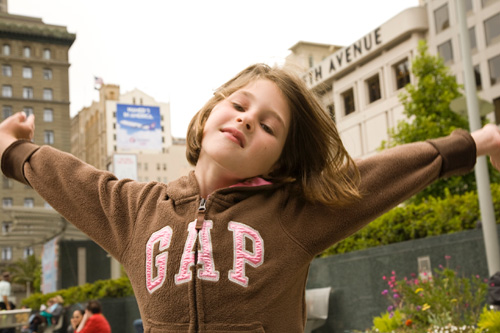
Grace Farris doesn’t look sick.
What she looks like is a 6-year-old girl: blowing bubbles, incapable of sitting still, and grinning to reveal the recent mass exodus of her baby teeth.
But for nearly three years, Grace has been shuttled in and out of hospitals and plagued by increasingly frequent seizures and the progressive weakening of her left side — the unpleasant byproducts of a benign tumor the size of a golf ball buried deep within her brain.
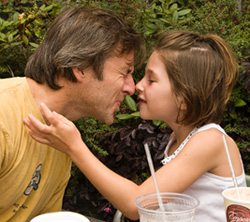
Grace and her father Michael Farris act silly in San Francisco’s Union Square the day before Grace’s brain surgery.
Surgeons at UCSF attempted to change the course of Grace’s illness on July 29 by removing the portion of the tumor they believed was causing the seizures. For her parents, Nikki and Michael, the surgery offered the first real glimmer of hope they have seen since their daughter fell ill—hope that she would begin to feel, and act, like her old self.
“It’s been extremely difficult having a child with a disability who looks fine,” Nikki Farris said the day before the surgery as Grace ran around San Francisco’s Union Square. “But we see the changes in her. She’s more aggressive and erratic, less focused. She’ll still have these glimpses of herself, but we grieve her and the person she used to be.”
Grace’s condition, a dysembryoplastic neuroepithelial tumor, or DNET, is relatively rare: UCSF has treated just 50 patients with a DNET in the past 15 years, according to Joseph Sullivan, MD, a pediatric neurologist and director of the UCSF Pediatric Epilepsy Center. It is commonly associated with medically intractable epilepsy — a form of the disorder that does not improve with medication.
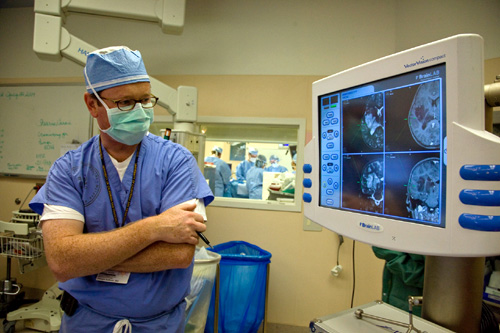
UCSF pediatric neurologist and epilepsy specialist Joseph Sullivan examines images of Grace’s brain as surgeons operate on her tumor.
While many DNETs can be treated through surgical removal, the size and location of Grace’s tumor makes the standard treatment impossible, said Sullivan, who has been Grace’s primary doctor since the Chico-based Farris family started coming to UCSF about two years ago.
“The problem with her tumor is that it’s so large and basically infiltrates a lot of important brain structures,” he said. “However, surgery became necessary when we could no longer get her seizures under control.”
By using an electroencephalogram (EEG) to measure Grace’s brain waves, Sullivan and his colleagues were able to hone in on the part of the tumor that seemed to be causing her seizures.
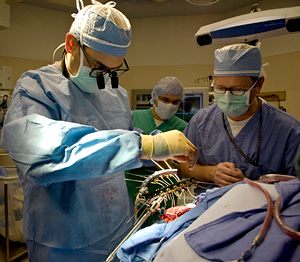
Nalin Gupta, UCSF’s chief of pediatric neurological surgery, works to remove the section of Grace’s brain tumor that doctors believe is causing her seizures, while neurologist Joseph Sullivan, right, looks on.
“We felt very confident they were coming from the front portion of the tumor, an area called the insula,” Sullivan said. “We felt that if we could remove a large portion of the tumor in that area, we would have a very good chance of significantly reducing her seizures.”
The surgery was performed by Nalin Gupta, MD, PhD, chief of pediatric neurological surgery at UCSF, and Mitchel Berger, MD, chair of the Department of Neurological Surgery and director of UCSF’s Brain Tumor Center, whose specialty is operating on tumors in and around the insula. The doctors removed just over half of the tumor, Sullivan said.
Paths Lead to UCSF
During the surgery, Grace experienced a small stroke in the area where the body’s motor pathways are located, but Sullivan said he expected “a near-complete recovery” and that the rest of the procedure went smoothly.
Two weeks later, Grace had not experienced any seizures, her mother said, though the stroke had impaired her motor skills on her left side. She was scheduled to remain in the hospital for about three more weeks of recovery and rehabilitation.
“It’s a tough road ahead of her with regards to rehab, but she’s improving daily,” Nikki Farris wrote in an Aug. 11 email message. “It’s not easy losing your left side [mobility], especially for a child who likes to be active. It is also not so easy for a child to understand the imperative nature of her working hard to get back her left side.”
Sullivan said the chances Grace will remain seizure-free are low, but he hopes the episodes will be significantly milder and less frequent moving forward. That would be a welcome change from the past year, when Grace was having up to four episodes a day at school, her mother said.
The family has received moral support from many places — Grace’s school, the Epilepsy Foundation, friends and relatives — but Nikki Farris said the doctors at UCSF have also played a huge role in getting them through such a harrowing situation.
“When Grace first got sick [in November 2006], we went all over the place meeting with doctors,” Nikki Farris said. “But through all of those meetings and all of my research, all paths continued to lead back to UCSF.”
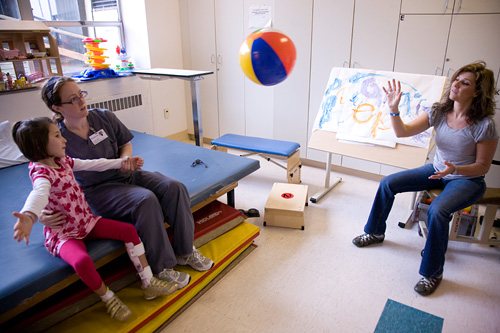
With help from her mother Nikki Farris, right, and UCSF occupational therapist Christina Carter, Grace works on her motor skills during a rehabilitation session on Aug. 17.
“Our experience has been wonderful,” she added. “It’s so hard to find all the doctors and experts you need in one place, but that’s what UCSF offers. And as for Joseph Sullivan, as far as we’re concerned, he walks on water.”
In 2009, UCSF Children’s Hospital ranked among the nation’s best children’s hospitals in neurology and neurosurgery, as well as eight other specialties, according to a survey by U.S. News & World Report.
The Farris’s said they hope that by calling attention to Grace’s story and the good work being done at UCSF, they might help raise the profile of pediatric brain tumors and, especially, epilepsy — conditions in desperate need of increased funding.
In the meantime, they are hoping for the best for their daughter and are holding on tightly to the moments when the “old Grace” reappears — moments like that July 28 afternoon in downtown San Francisco when the little girl was eager to perform what she calls her “princess curtsies,” a series of elaborate moves meant to evoke various members of Disney royalty.
“Show me what a princess does,” her mother requested.
Without a moment’s hesitation, Grace swept one leg behind the other, flung both arms out like wings and bowed deeply for a few seconds before whipping her head up and —as any 6-year-old would — collapsing into giggles.
Photos by Susan Merrell
Related Links:
UCSF Children’s Hospital Ranked among Best Nationwide in Nine Pediatric Specialties
UCSF News Release, June 17, 2009
Pediatric Neurological Surgery at UCSF